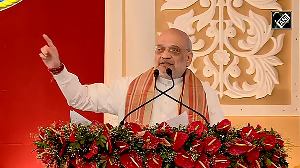In rural India, carrying around a $44 mobile phone can be something of a status symbol. Or at least it has been for Pandurang Narayan Shelke, a 55-year-old farmer in Latur, a village in the west Indian state of Maharashtra.
Last January his son, who works as a porter at Bombay's Victoria Terminus railway station, bought him a low-end Nokia 1100 handset. Shelke had coveted one for years. And, now, "my stock has gone up considerably with my poor relatives, as I can talk to my son whenever I want," he says.
Shelke's small step into the world of wireless communications is part of a much larger drama unfolding in the Indian telecom market, once a backwater but now the world's fastest-growing after China. The number of fixed and wireless telephone connections has doubled in the past two years, to about 150 million, and Indians are signing up for mobile-phone service at an extraordinary five million new wireless connections a month.
The Ministry of Telecom has set a target for India to have 250 million connections and mobile coverage for 85% of the country -- from about 30% today -- some time in 2007.
Massive build-out
This is explosive growth, no question. And there could be much more to come if New Delhi is serious about improving the lot of rural India, home to two-thirds of the country's one billion-plus population but with precious few workable phone lines. Most analysts believe that wireless mobile networks and affordable handsets could quickly change all that.
Indian Prime Minister Manmohan Singh's government has rolled out the welcome mat to global wireless operators and handset manufacturers to invest in the country's massive telecom build-out, and domestic companies are expanding rapidly, too.
"India has reached a take-off point in telecom," says Ashim Ghosh, managing director of Hutchison Essar, a joint venture between India's Essar Group and Hutchison Telecom, based in Hong Kong.
While India has a very long way to go in establishing a nationwide network of landline telecom networks, let alone high-speed broadband service, paradoxically, the country could overtake China in the next several years in terms of mobile-phone subscription growth.
Rolling out towers and base stations to support wireless networks certainly isn't cheap. But it likely will be wireless networks -- not copper-wire fixed lines -- that do most to pull India out of the telecommunication dark ages.
Talk is cheap
While India often gets a deserved rap for its rigid labor laws and heavy regulation in some sectors, that's really not true when it comes to telecom, which New Delhi started liberalizing back in the mid '90s. Telecom tariffs imposed on domestic voice services have dropped steadily, and today India enjoys the lowest call rates in the world at 2 cents per minute, compared to 33 cents in Japan, 11 cents in Brazil, and 24 cents in Australia.
The arrival of a sizable market of wireless phone subscribers -- India's mobile phone user base has exploded to 105 million today from 5 million in 2001 -- is also driving down the price of handsets.
That's encouraging relatively well-off urban consumers to trade up to more feature-laden phones and creating a heat blast of desire among the big chunk of the population who haven't yet tried one. "There's an insatiable hunger for mobile phones permeating all layers of society," says Pankaj Mohindroo, president of the Indian Cellular Assn., a trade group.
And India's relatively "lower ownership of handsets, low call rates, and spreading out of networks is having a cascading effect on affordability," adds Sanjeev Aga, director Idea Cellular, which is owned by the Aditya Birla group, one of India's leading business conglomerates.
India's rise as a mobile phone megamarket also comes at a time of market saturation in Europe, Japan, and the U.S. Global handset makers such as Nokia, Motorola and LG Electronics all see emerging markets such as India as key revenue drivers for the industry in the years ahead.
The trick in India is positioning stellar brands at the low end of the market. Nokia, for instance, sells about 45 models in India. Yet its biggest seller, accounting for 15% of sales in India, is the basic 1100 model for $44 that is turning heads in villages like Latur. Motorola will launch a handset for under $30
Nokia has established a big, early lead in India with a dominant 63% share, followed by LG (13%), Motorola (8.5%) and Samsung (3.5%), which may have made a strategic mistake globally by sticking to high-end, feature-loaded handsets.
There could be rollicking good times ahead for handset makers with the right business model in India. Analysts think there is a replacement market in the 85 million range (mostly better-off urban dwellers) already in place. Moreover, India's relatively young population -- it is home to the biggest under-25 age cohort on the planet -- suggests a steady stream of first-time subscribers.
Early in 2006 Nokia opened a handset factory in Madras that is churning out one million handsets a month, and company executives think they could eventually sell 400 million mobile phones in India.
Hooking up the hinterland
That said, there are huge challenges that, if unresolved, could disrupt the India growth curve. To really develop India's full potential, local telecom providers will need to spend massive amounts of money to expand coverage to the country's sprawling rural regions.
"A lot depends on how fast the players roll out their networks into the rural hinterland," says Kuldeep Goyal, a general manager with the government-owned telecom carrier BSNL.
That's key because growth is starting to become less stellar in big urban centers such as New Delhi and Mumbai. "With the metros stabilizing, growth has to fan out to potential rural markets," says Srinivas Rao, telecom analyst at Enam Securities.
A bigger market would also presumably help lift a key metric like average revenue per user. The dominant Global System for Mobile (GMS) mobile phone averages $14 per user in India vs. nearly $20 in China. For mobile handsets using Code Division Multiple Access (CDMA) technology, the revenue per user in India is only about $5.60, compared to $9.31 in China.
The good news is that sizable investments are underway. BSNL is spending around $4 billion over the next three years on rural coverage as well as broadband and optical fiber network expansion. In its largest markets, such as the states of Maharashtra and Goa, it will increase its 1,200 base stations to 3,000 by March of 2007.
Another major India telecom, Reliance Infocomm, is expected to invest around $550 million through the end of the decade, mainly outside of major urban centers.
Tata Teleservices will spend $214 million this year on infrastructure, network expansion, and transmission, according to CEO Darryl Green. On top of that, Bharti Airtel, India's largest wireless player, will devote $1.8 to $2 billion in 2007 on similar expansions.
"It will be commensurate with our strategy on aggressive expansion plans to capture the first mover advantage," says Manoj Kohli, president of Bharti Airtel.
Other challenges are really outside the telecom industries' control. India still needs to make major investments in the country's inadequate power grid. New towers and base stations for wireless networks won't help much if power outages (an all-too-common feature in rural India) continue.
The government also needs to move faster to free up more radio spectrum to support 3G handsets and high-speed wireless connections. More "spectrum is required," says Adlane Fellah, a research analyst with Montreal research firm Maravedis, "for the government to realize it ambitious telephone and broadband penetration objectives."
Qualcom's cut
And for foreign players hoping to break into India, keeping the government happy isn't always a cakewalk. The San Diego wireless technology powerhouse Qualcomm has managed to irritate both the government and the powerful telecom player Reliance by refusing to lower the royalties it charges Indian companies using its CDMA technology.
Tata Teleservices' Green says Qualcomm charges Indian players 7% of handset costs compared to 2% in China. It is a disparity that enrages India.
Qualcomm CEO Paul Jacobs, who recently visited India, thinks the real issue is working with phone manufacturers to lower costs, not cutting its company's royalty fee, and for the government to get more enlightened about allocating radio spectrum.
"CDMA is better for data delivery, but these things are getting somewhat minimized by the way the government is allocating spectrum," says Jacobs. Reliance has threatened to drop its CDMA phones and shift to GSM if Qualcomm doesn't budge.
These problems aside, though, it is hard to argue that India's mobile-phone industry isn't destined for big things later in the decade. India knows its economic future, not to mention the living standards of hundreds of millions of rural citizens, depends on a societal embrace of wireless technologies.
The potential demand is there and so is the commitment from global handset makers and domestic telecom players. Right now, owning a mobile phone in rural India is a big deal. Five years out, with any luck, it will elicit yawns.






 © 2025
© 2025